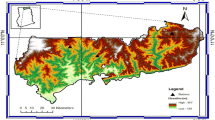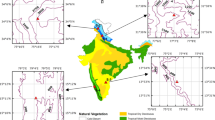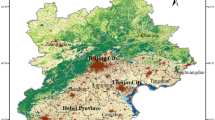Abstract
Normalized Difference Vegetation Index (NDVI) is widely recognized as a good indicator of vegetation productivity. Diagnosing the NDVI trend and understanding climatic factors influences on NDVI can predict the productivity changes under different climatic scenarios. This paper examined NDVI dynamic and its response to climate factors during a 10 year period (1998–2008) in Inner Mongolia. The main findings are as follows: (1) The NDVI multi-scale characters can be revealed well by wavelet transform, and the average NDVI and the NDVI amplitude show a gradually decreased trend from northeast to southwest in Inner Mongolia during the past 10 years, furthermore, this trend is consistent with the heat and water distribution caused by latitude difference in north–south direction and Asia monsoon effect in east–west direction. (2) The relation between NDVI and temperature is the most close, followed by precipitation, sunshine hours and relative humidity. Different vegetation cover types show different strengths in correlation between NDVI and climate variables with the correlation values decreasing from forest, meadow steppe to desert steppe in whole. (3) The precipitation and temperature have the same change cycle, both nearly 290 days in the 20 selected stations. The NDVI has the same change cycle with the precipitation and temperature or either 10 days earlier or later than precipitation and temperature, which supports the significant correlation between NDVI and its climatic factors from a new perspective. The nearly 290 days change cycle implies that the vegetation growth cycle is nearly 10 months and there are no obvious differences change cycles in different vegetations. (4) Vegetation dynamic is significantly correlated to the temperature and precipitation at the time scale of 10, 20, 40, 80, 160, and 320-day, respectively, and the S3 scale (i.e., the time scale of 80-day), nearly 3 months (one season), is most significant and suitable for evaluating the vegetation dynamic to climatic factors.












Similar content being viewed by others
References
Asrar G, Fuchs M, Kanemasu E, Hatfield J (1984) Estimating absorbed photosynthetic radiation and leaf area index from spectral reflectance in wheat. Agron J 76:300–306
Azzali S, Menenti M (2000) Mapping vegetation-soil-climate complexes in southern Africa using temporal Fourier analysis of NOAA-AVHRR NDVI data. Int J Remote Sens 21(5):973–996
Borak JS, Lambin EF, Strahler AH (2000) The use of temporal metrics for land cover change detection at coarse spatial scales. Int J Remote Sens 21(6):1415–1432
Bradley BA, Jacob RW, Hermance JF, Mustard JF (2007) A curve fitting procedure to derive inter-annual phenologies from time series of noisy satellite NDVI data. Remote Sens Environ 106(2):137–145
Bruce LM, Koger CH, Jiang L (2002) Dimensionality reduction of hyperspectral data using discrete wavelet transform feature extraction. Geosci Remote Sens IEEE Trans 40(10):2331–2338
Bruzzone L, Smits PC, Tilton JC (2003) Foreword special issue on analysis of multitemporal remote sensing images. Geosci Remote Sens IEEE Trans 41(11):2419–2422
Cao M, Woodward FI (1998) Dynamic responses of terrestrial ecosystem carbon cycling to global climate change. Nature 393(6682):249–252
Chamaille-Jammes S, Fritz H, Murindagomo F (2006) Spatial patterns of the NDVI-rainfall relationship at the seasonal and interannual time scales in an African savanna. Int J Remote Sens 27(23):5185–5200
Churkina G, Running SW (1998) Contrasting climatic controls on the estimated productivity of global terrestrial biomes. Ecosystems 1(2):206–215
Coppin P, Jonckheere I, Nackaerts K, Muys B, Lambin E (2004) Review ArticleDigital change detection methods in ecosystem monitoring: a review. Int J Remote Sens 25(9):1565–1596
Davenport ML, Nicholson SE (1993) On the relation between rainfall and the Normalized Difference Vegetation Index for diverse vegetation types in East Africa. Int J Remote Sens 14(12):2369–2389
de Beurs KM, Henebry GM (2005) A statistical framework for the analysis of long image time series. Int J Remote Sens 26(8):1551–1573
Diodato N, Bellocchi G (2008) Modelling vegetation greenness responses to climate variability in a Mediterranean terrestrial ecosystem. Environ Monit Assess 143(1–3):147–159. doi:10.1007/s10661-007-9964-z
Echer E (2004) Multi-resolution analysis of global total ozone column during 1979?1992 Nimbus-7 TOMS period. Ann Geophys 22(5):1487–1493
Eidenshink JC, Faundeen JL (1994) The 1 km AVHRR global land data set: first stages in implementation. Int J Remote Sens 15(17):3443–3462
Fabricante I, Oesterheld M, Paruelo JM (2009) Annual and seasonal variation of NDVI explained by current and previous precipitation across Northern Patagonia. J Arid Environ 73(8):745–753
Farge M (1992) Wavelet transforms and their applications to turbulence. Annu Rev Fluid Mech 24:395–457. doi:10.1146/annurev.fl.24.010192.002143
Freitas RM, Shimabukuro YE (2008) Combining wavelets and linear spectral mixture model for MODIS satellite sensor time-series analysis. J Comput Interdiscip Sci 1(1):51–56
Galford GL, Mustard JF, Melillo J, Gendrin A, Cerri CC, Cerri CEP (2008) Wavelet analysis of MODIS time series to detect expansion and intensification of row-crop agriculture in Brazil. Remote Sens Environ 112(2):576–587
Goward SN, Dye DG (1987) Evaluating North American net primary productivity with satellite observations. Adv Space Res 7(11):165–174
Hall-Beyer M (2003) Comparison of single-year and multiyear NDVI time series principal components in cold temperate biomes. Geosci Remote Sens IEEE Trans 41(11):2568–2574
Hirosawa Y, Marsh SE, Kliman DH (1996) Application of standardized principal component analysis to land-cover characterization using multitemporal AVHRR data. Remote Sens Environ 58(3):267–281
Jobbágy EG, Sala OE, Paruelo JM (2002) Patterns and controls of primary production in the Patagonian steppe: a remote sensing approach. Ecology 83(2):307–319
Jönsson P, Eklundh L (2004) TIMESAT-a program for analyzing time-series of satellite sensor data. Comput Geosci 30(8):833–845
Kaufmann RK, Zhou L, Myneni RB, Tucker CJ, Slayback D, Shabanov NV, Pinzon J (2003) The effect of vegetation on surface temperature: a statistical analysis of NDVI and climate data. Geophys Res Lett 30(22):2147. doi:10.1029/2003GL018251
Knapp AK, Smith MD (2001) Variation among biomes in temporal dynamics of aboveground primary production. Science 291(5503):481–484. doi:10.1126/science.291.5503.481
Labat D (2005) Recent advances in wavelet analyses: part 1. A review of concepts. J Hydrol 314(1–4):275–288
Lau KM, Weng H (1995) Climate signal detection using wavelet transform: how to make a time series sing. Bull Am Meteorol Soc 76(12):2391–2402
Maisongrande P, Duchemin B, Dedieu G (2004) VEGETATION/SPOT: an operational mission for the Earth monitoring; presentation of new standard products. Int J Remote Sens 25(1):9–14
Mallat SG (1989) A theory for multiresolution signal decomposition: the wavelet representation. IEEE Trans Pattern Anal Mach Intell 11(7):674–693
Malo A, Nicholson S (1990) A study of rainfall and vegetation dynamics in the African Sahel using normalized difference vegetation index. J Arid Environ 19:1–24
Martínez B, Gilabert MA (2009) Vegetation dynamics from NDVI time series analysis using the wavelet transform. Remote Sens Environ 113(9):1823–1842
Nemani RR, Keeling CD, Hashimoto H, Jolly WM, Piper SC, Tucker CJ, Myneni RB, Running SW (2003) Climate-driven increases in global terrestrial net primary production from 1982 to 1999. Science 300(5625):1560–1563
Nicholson SE, Farrar TJ (1994) The influence of soil type on the relationships between NDVI, rainfall, and soil moisture in semiarid Botswana. I. NDVI response to rainfall. Remote Sens Environ 50(2):107–120
Pielke RA, Avissar R, Raupach M, Dolman AJ, Zeng XB, Denning AS (1998) Interactions between the atmosphere and terrestrial ecosystems: influence on weather and climate. Glob Change Biol 4(5):461–475
Prince SD (1991) Satellite remote sensing of primary production: comparison of results for Sahelian grasslands 1981–1988. Int J Remote Sens 12(6):1301–1311
Ramsey JB (1999) Regression over timescale decompositions: a sampling analysis of distributional properties. Econ Syst Res 11(2):163–184
Sakamoto T, Yokozawa M, Toritani H, Shibayama M, Ishitsuka N, Ohno H (2005) A crop phenology detection method using time-series MODIS data. Remote Sens Environ 96(3–4):366–374
Schultz PA, Halpert MS (1993) Global correlation of temperature, NDVI and precipitation. Adv Space Res 13(5):277–280
Stockli R, Vidale PL (2004) European plant phenology and climate as seen in a 20-year AVHRR land-surface parameter dataset. Int J Remote Sens 25(17):3303–3330. doi:10.1080/01431160310001618149
Tucker CJ, Vanpraet CL, Sharman MJ, Van Ittersum G (1985) Satellite remote sensing of total herbaceous biomass production in the Senegalese Sahel: 1980–1984. Remote Sens Environ 17(3):233–249
Udelhoven T, Stellmes M, del Barrio G, Hill J (2009) Assessment of rainfall and NDVI anomalies in Spain (1989–1999) using distributed lag models. Int J Remote Sens 30(8):1961–1976
Wang J, Rich PM, Price KP (2003) Temporal responses of NDVI to precipitation and temperature in the central Great Plains, USA. Int J Remote Sens 24(11):2345–2364
Wang H, Li X, Long H, Zhu W (2009) A study of the seasonal dynamics of grassland growth rates in Inner Mongolia based on AVHRR data and a light-use efficiency model. Int J Remote Sens 30(14):3799–3815
Xu JH, Li WH, Ji MH, Lu F, Dong S (2010) A comprehensive approach to characterization of the nonlinearity of runoff in the headwaters of the Tarim River, Western China. Hydrol Process 24(2):136–146. doi:10.1002/hyp.7484
Xu JH, Chen YN, Li WH, Yang Y, Hong YL (2011a) An integrated statistical approach to identify the nonlinear trend of runoff in the Hotan River and its relation with climatic factors. Stoch Environ Res Risk Assess 25(2):223–233. doi:10.1007/s00477-010-0433-9
Xu JH, Chen YN, Lu F, Li WH, Zhang LJ, Hong YL (2011b) The nonlinear trend of runoff and its response to climate change in the Aksu River, western China. Int J Climatol 31(5):687–695. doi:10.1002/joc.2110
Zeng B, Yang TB (2008) Impacts of climate warming on vegetation in Qaidam Area from 1990 to 2003. Environ Monit Assess 144(1–3):403–417. doi:10.1007/s10661-007-0003-x
Zhong L, Ma Y, Salama M, Su Z (2010) Assessment of vegetation dynamics and their response to variations in precipitation and temperature in the Tibetan plateau. Clim Chang 1–17. doi:10.1007/s10584-009-9787-8
Zimmerman DW (1986) Tests of significance of correlation coefficients in the absence of bivariate normal populations. J Exp Educ 54(4):223–227
Acknowledgments
This work was supported by National Natural Science Foundation of China (Grant No. 41040015), and the Open Project of the Key Lab of Oasis Ecology of the Education Ministry PRC, Xinjiang University (Grant No. xjdx0201-2006001).
Author information
Authors and Affiliations
Corresponding author
Rights and permissions
About this article
Cite this article
Yang, Y., Xu, J., Hong, Y. et al. The dynamic of vegetation coverage and its response to climate factors in Inner Mongolia, China. Stoch Environ Res Risk Assess 26, 357–373 (2012). https://doi.org/10.1007/s00477-011-0481-9
Published:
Issue Date:
DOI: https://doi.org/10.1007/s00477-011-0481-9




